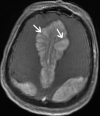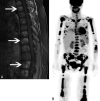Erdheim-Chester disease of the central nervous system: new manifestations of a rare disease
- PMID: 21960492
- PMCID: PMC7964409
- DOI: 10.3174/ajnr.A2707
Erdheim-Chester disease of the central nervous system: new manifestations of a rare disease
Abstract
Background and purpose: ECD is a rare non-Langerhans-cell histiocytosis, which can involve the CNS; therefore, CNS imaging findings have been described in only a small number of patients. To gain additional insight into the CNS manifestations of ECD, we reviewed the findings on imaging of the brain, head and neck, and spine in patients with ECD who presented to our institution. Here, we illustrate manifestations that have not, to our knowledge, been previously described.
Materials and methods: CT, MR imaging, and PET/CT studies of the brain, maxillofacial region, and spine were reviewed in 11 patients with ECD.
Results: Four new manifestations of ECD were present, including the following: a stellate appearance of intracranial extra-axial lesions, ependymal enhancement along the lateral ventricle with deep linear extension to the lentiform nucleus, irregular enhancement in the pons, and diffuse involvement of the vertebral column on PET/CT.
Conclusions: ECD has a variety of imaging appearances in the CNS, including new manifestations described herein. Neuroradiologists should be aware of these manifestations to avoid mistaking them for other disease processes.
Figures






References
-
- Veyssier-Belot C, Cacoub P, Caparros-Lefebvre D, et al. . Erdheim-Chester disease: clinical and radiologic characteristics of 59 cases. Medicine 1996;75:157–69 - PubMed
-
- Bohlega S, Alwatban J, Tulbah A, et al. . Cerebral manifestation of Erdheim-Chester disease: clinical and radiologic findings. Neurology 1997;49:1702–05 - PubMed
-
- Gottlieb R, Chen A. MR findings of Erdheim-Chester disease. J Comput Assist Tomogr 2002;26:257–61 - PubMed
-
- Drier A, Haroche J, Savatovsky J, et al. . Cerebral, facial, and orbital involvement in Erdheim-Chester disease: CT and MR imaging findings. Radiology 2010;255:586–94 - PubMed
MeSH terms
LinkOut - more resources
Full Text Sources
Medical
